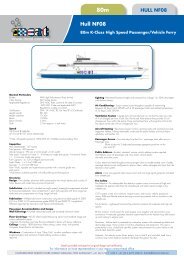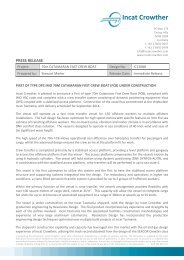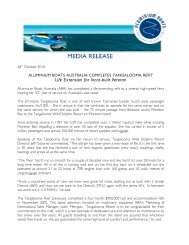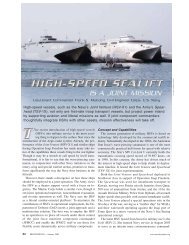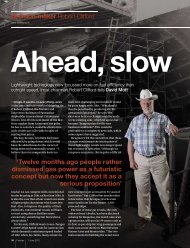US NAVY'S - Incat
US NAVY'S - Incat
US NAVY'S - Incat
You also want an ePaper? Increase the reach of your titles
YUMPU automatically turns print PDFs into web optimized ePapers that Google loves.
New Engine Targets<br />
Power, Economy and<br />
Ecology<br />
INCAT was recently a “launch customer” for the first of<br />
MAN Diesel’s new high power density engine, the type<br />
28/33D. In this way, the 28/33D takes over seamlessly from<br />
an illustrious predecessor: the MAN Diesel Ruston RK270<br />
had been the engine of choice in INCAT fast multi-hull<br />
ferries ever since the Hoverspeed Great Britain took the<br />
Blue Riband (Hales Trophy) for the fastest Atlantic Crossing<br />
by a passenger ship on its maiden voyage in 1990.<br />
As well as increased power output - the 28/33D is offered<br />
in 12V, 16V and 20V versions in a power range from 5400<br />
to 9000 kW – the new engine also features improved<br />
specific fuel consumption and exhaust emissions. The<br />
improvements are based on the latest engine technology,<br />
including state-of-the-art combustion chamber and<br />
porting geometry and an electronically controlled fuel<br />
injection system.<br />
Always strongly interrelated, fuel consumption and<br />
emissions are ever more inextricably linked. Legal limits on<br />
the harmful emissions from combustion engines have been<br />
in force for many years and, more recently, were joined<br />
THE NEXT STEP IN ELECTRONIC ENGINE MANAGEMENT<br />
FROM MAN DIESEL, “SaCoSone” THE ACRONYM STANDS<br />
FOR “SAFETY AND CONTROL SYSTEM” AND THE SUFFIX FOR<br />
“ON ENGINE, - THE SYSTEM IS VERY COMPACT AND WILL BE<br />
MOUNTED ON THE STRUCTURE OF THE 28/33D.<br />
GRAPH OF THE EVOLUTION OF TYPICAL FUEL<br />
CONSUMPTION LEVELS FOR LARGE HIGH<br />
POWER DENSITY DIESEL ENGINES. YEAR ON<br />
YEAR IMPROVEMENTS MEAN THE DIESEL<br />
ENGINE HAS NEVER BEEN OVERTAKEN AS<br />
THE MOST FUEL EFFICIENT MARINE PRIME<br />
MOVER. ACCORDINGLY, THE 28/33D<br />
FEATURES A 5 TO 7% REDUCTION IN SPECIFIC<br />
FUEL CONSUMPTION AT UNCHANGED NOX<br />
EMISSIONS COMPARED WITH ITS IMMEDIATE<br />
PREDECESSOR.<br />
THE NEXT HURDLE FOR MARINE ENGINE EMISSIONS – “IMO TIER II”<br />
18 <strong>Incat</strong> THE Magazine Issue 36



